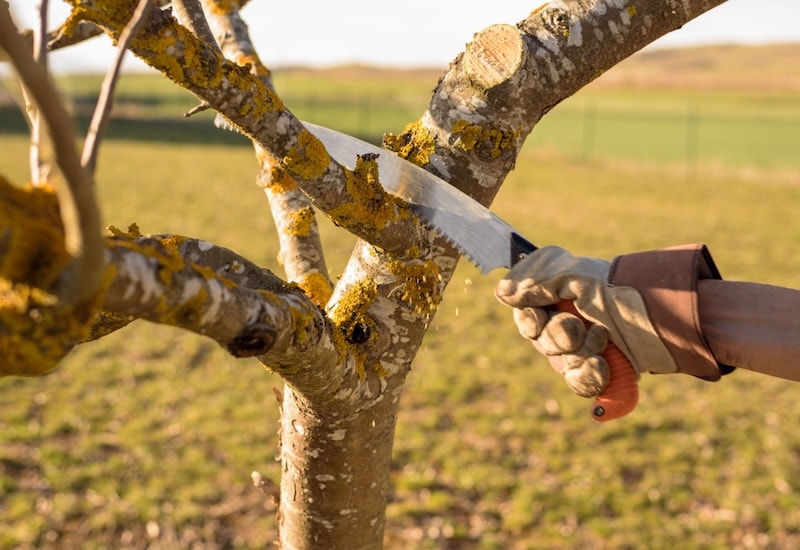Last Updated on September 5, 2024 by Suttons Horticultural Team
If you’re growing apple trees, you need to know how and when to prune them. Correct pruning isn’t just about creating a well-shaped tree. It’s about allowing plenty of light and air to reach the ripening fruits while encouraging the new growth which will bear fruit in the future. If that sounds complicated, don’t worry; it’s easy enough when you know how. Here are some top tips from our horticultural team to help you train and prune your apple trees to perfection.
Browse our full range of apple trees to find the best varieties for your patio or garden.
What are the best tools for pruning apple trees?
To prune your apple trees, you’ll need a pair of loppers, secateurs, a pruning saw, gloves, and a sturdy ladder which won’t topple over. When using ladders, always put safety first – wear stout shoes or boots with a heel, and when climbing, maintain three points of contact with the ladder at all times. Wear eye protection when pruning, and before moving from one tree to another, always disinfect your tools to help prevent cross-infection.
Why prune apple trees?
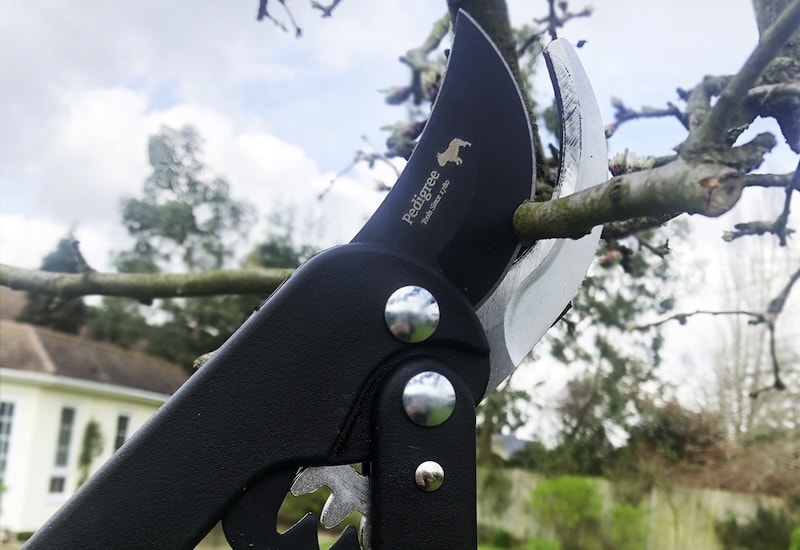
Image: Geared Bypass Lopper from Suttons
The point of pruning is twofold. First, you’re aiming to remove dead, damaged, and diseased wood to maintain the health and vitality of the tree. Second, opening the tree up to the light and enabling good air circulation helps the tree stay healthy, while removing the right shoots and correctly shortening the growing tips promotes heavy fruiting.
When to prune apple trees
For freestanding trees – standards or bushes, the dormant season between November and March is the best time to prune. This is when the tree’s resources are safely locked away in the roots, minimising stress.
For trained apple trees – cordons and fans – pruning is a summer job best tackled in later in the season, preferably when the risk of secondary growth has passed. You’ll need to play things by ear a bit, taking into account your tree’s vigour, the weather and how far north you live. Sometime in mid to late-August or into September is usually best.
How to prune bush apple trees
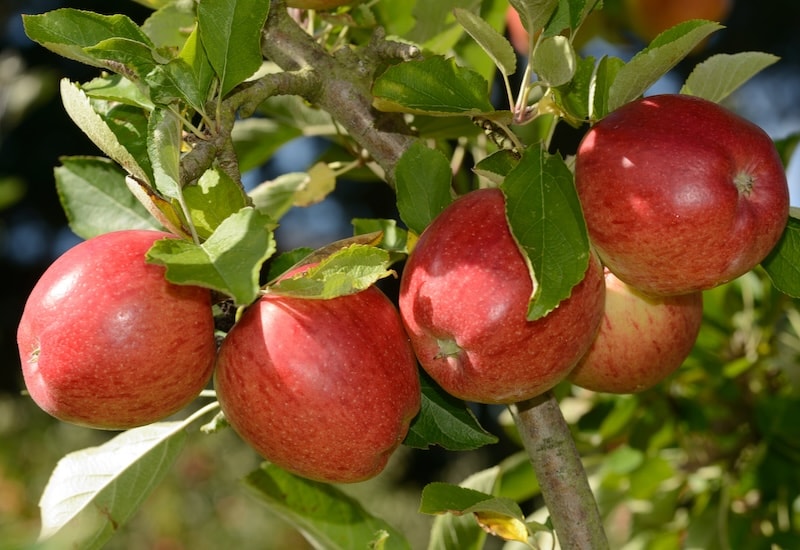
Image: Apple ‘Braeburn’ from Suttons
Bush apple trees are the most common. The aim here is to keep a maximum of 5 or 6 main branches that will form the main structure of the tree for life. Try to create an open goblet shape. Sub-branches of these will bear most of the fruit, and these should be removed as they reach about four years old, allowing replacements to grow. Pruning your bush trees each winter maintains the bulk of the tree in a ‘young’ state, ensuring maximum productivity.
- Bush trees should be planted about 3–3.5m apart.
- Once planted, remove the central leader – the main stem – just above the highest side branch or feather. This encourages the feathers to develop.
- Select 5 or 6 of the strongest and best-placed ones to form the main frame of the apple tree.
- Over the next three seasons, you only need to cut these selected branches back by about one-third in winter to encourage sub-branch development.
- From year 4 onwards, remove older sub-branches, making sure that you cut at a point at which a new branch will grow to maintain a healthy, productive branch structure.
- Aim to limit the height of the tree to around 2.4m (8′). and expect your tree to be yielding up to 22kg (50lb) of fruit once it reaches 5 years of age.
How to prune crab apples

Image: Crab Apple ‘Butterball’ from Suttons
Crab apples tend to become quite spindly if left to their own devices. To counter this, prune them like bush apple trees to produce an ‘open-centred’ tree. We recommend reducing branches by about one-third every other year whilst dormant to encourage stronger growth. This has the additional benefit of improving fruit size and health.
How to prune central leader apple trees
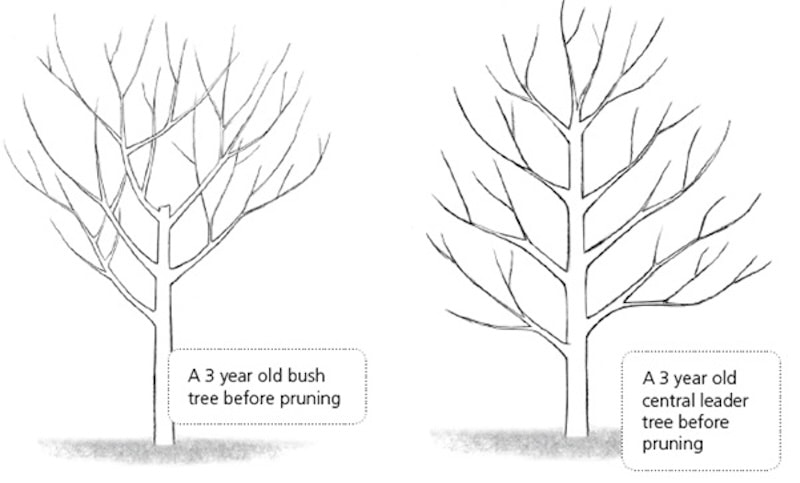
Image: Suttons
Central leader apple trees are the product of a very popular and traditional pruning method which gives regular heavy crops and allows plenty of light into the tree.
- Plant your trees 2.4m (8′) apart, and if you’re planting more than one row, stagger them in a zigzag pattern with 1.2–1.5m (4–5′) between rows.
- Each tree needs a centre supporting stake about 1.8m (6′) high.
- Once planted, cut back the main stem by about 10–30cm. This allows the rapid development of side branches, which you should restrict to a maximum of 10 in number.
- The most central of these branches becomes the new leader, and this should be allowed to run up the supporting post to a height of no more than 2.1m (7′).
- The remaining branches will radiate out from this. Sub branches along the length of these side branches will bear the fruit.
- To promote better crops in the early years, weigh or tie down the side branches to encourage horizontal growth.
- To keep fruiting wood young and productive, remove the main branches in turn every few years, allowing a new replacement to grow.
- A 5-year-old tree can be expected to produce around 18kg (40lb) of fruit.
How to prune cordon apple trees
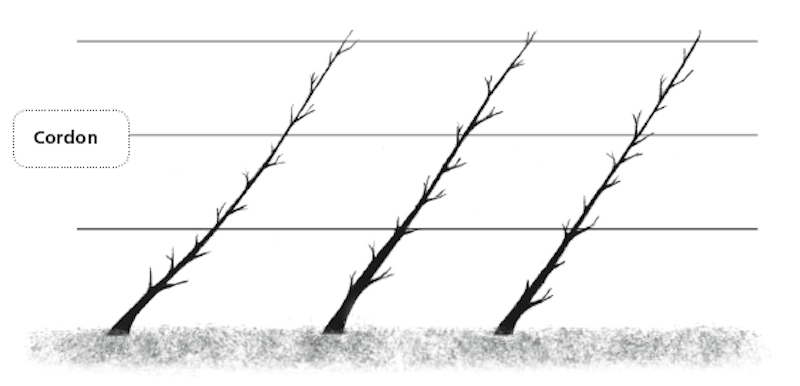
Image: Suttons
An excellent way of growing apple trees in small spaces, cordon training your apple trees utilises ground very efficiently, combining close planting distances with a compact style.
- First, you need to build a sturdy framework of 1.8–2.1m (6–7′) posts strung with horizontal supporting wires.
- Plant your apple trees against the wire at an angle of 30 degrees along a 2.4m (8′) bamboo cane which has been attached to the wires.
- Space trees 45cm (18″) apart.
- If possible, your rows should run north to south with trees pointing north, as this will expose them to maximum sunlight throughout the day.
- As the tree grows, encourage it to twist around the cane to encourage small fruiting branches to break out at the point of bend.
- Apples will grow on the small branches which sprout along the length of the main stem.
- Winter pruning consists of spacing the side branches to about every 23cm (9″) and eventually removing branches that reach 4 years old.
- Damaged or misplaced branches are also best removed at this time.
- Summer prune your cordons in mid to late-August to encourage fruit bud formation for the following year.
- At this time, cut all new growth back to 2 to 3 buds.
- After 5 years, you can anticipate yields of around 7kg (15lb) per apple tree.
How to grow apples using the ‘V’ system
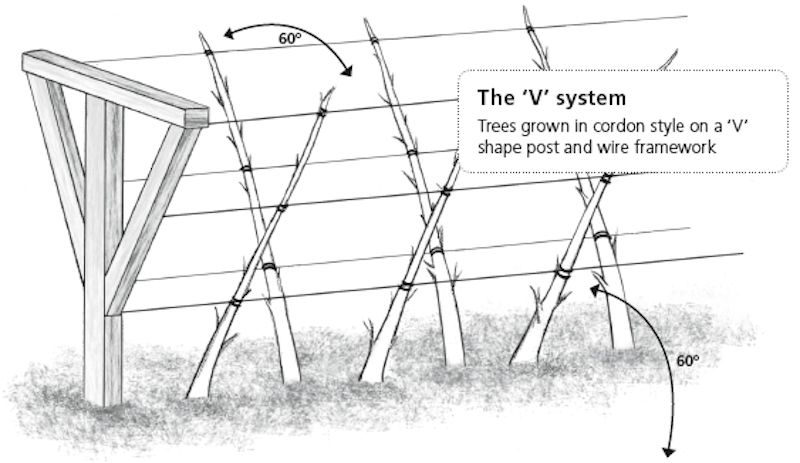
Image: Suttons
Commercial fruit farms use this adaptation of the cordon method to cram even more apple trees into as small an area as possible. Plant the trees alternately, 45cm (18″) apart, attaching them to wires along a row at an angle of 60 degrees to the ground to form a V along the row – check out the diagram to see the structure of the posts and the layout of the wires and trees. The general culture and pruning is the same as for cordon apple trees.
This way of planting helps the trees to intercept a very high proportion of the available sunlight, producing great quality fruit. After 5 years, yields of 4.5kg (10lb) per tree are not uncommon. Investing in a V system enables you to grow around 45kg (100lb) of apples in a space the size of a 4.5m (15′) row of runner beans!
How to grow apples using the ‘S’ system
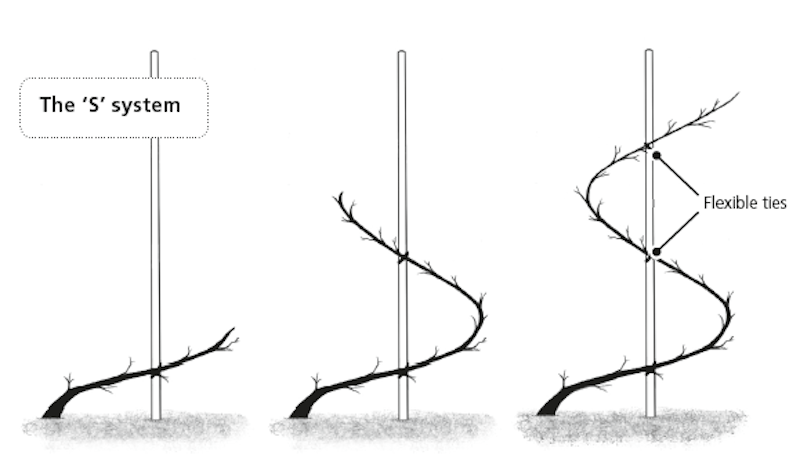
Image: Suttons
The ‘S’ system takes advantage of the trees’ tendency to respond to moderate stress by producing increased yields of fruit and is one of the latest techniques to appear in commercial nurseries. The natural habit of a tree is to grow vertically in response to light and forces of gravity, but if you bend the stem against these forces, the apple tree responds by producing small sub-branches at the point of bend. These in turn, bear fruit buds the following year.
- Plant the trees and securely fasten them at an angle of about 30 degrees to the ground across strong 1.8m (6′) vertical stakes.
- Plant the trees 110cm (3′ 6″) or a little more apart.
- In June of the first two years, when growth is strong and the wood is sappy and flexible, bend the tree back and forward again, ultimately forming an ‘S’ against the stake.
- Pruning needs are relatively light, and none is needed until the second year.
- After that, remove the side branches as they age beyond four years to maintain young, productive wood.
- The main stem will be severely retarded by bending, and so can be left untouched.
- After 5 years, you can expect a crop of about 9kg (20lb) per tree.
Double ‘U’ cordon trees
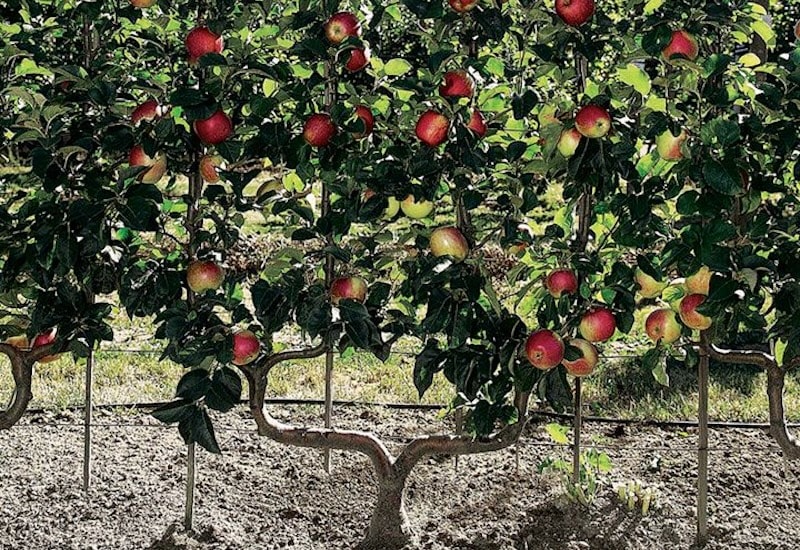
Image: Suttons
Special horticultural techniques are used to give double ‘U’ cordon trees their unique form. Sold pre-trained, it’s really vital to give them plenty of support after planting to get the most from them. To do this, construct a sturdy frame against which the apple tree can grow or else provide a stake to support each vertical trunk.
These trees are perfect for growing against a wall and, in this case, use a trellis or canes attached to wires to support the branches. Caring for double ‘U’ cordon trees is straightforward – just treat each vertical stem as a single cordon. Prune in winter to ensure lateral branches do not become crowded and to maintain the original form as the tree grows. Any damaged branches should also be removed at this time. Do your summer pruning around the last week in June, cutting new growth back to 2 or 3 buds.
Pruning columnar apple trees
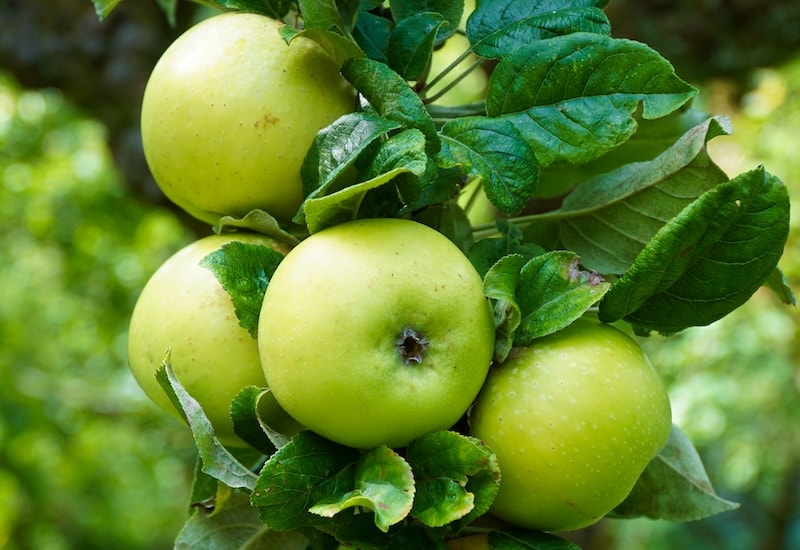
Image: Apple (Malus) ‘Limelight’ from Suttons
Perfect for people who don’t have much outdoor space, columnar apple trees don’t have side branches, giving a skinny tree which rises to about 8’ high and produces regular-size apples. The general care of columnar apple trees is the same as other types. These trees are pruned twice a year, in June and again when the tree is dormant during the winter months. In both cases, the new growth is cut back to a bud 20cm (8″) from the old wood.
Pruning and training apple trees can seem daunting, but by following a few simple rules, it’s an easy job for most gardeners. By making the right pruning decisions at the correct time of year, you’re sure to enjoy crops of juicy, delicious apples. If you’re interested in growing apple trees, head over to our expert guide to planting bare root plants where you’ll find lots of helpful advice.
Lead image: Shutterstock

